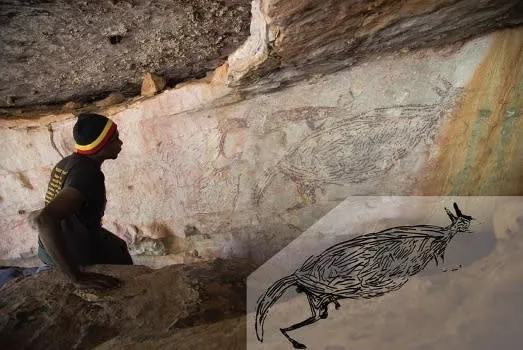17,000-Year-Old Kangaroo Painting Is Oldest-Known Australian Rock Art
Researchers were able to date the painting using a new technique involving wasps’ nests
/https://tf-cmsv2-smithsonianmag-media.s3.amazonaws.com/filer/c4/a8/c4a8d8cc-ee19-4e8f-ad78-8b90d879a707/kangaroo.jpg)
Researchers have discovered that a six-foot-long painting of a kangaroo on the ceiling of a rock shelter was created between 17,500 and 17,100 years ago, making it Australia’s oldest known intact rock art. While the images had been known to researchers since the 1990s (and likely known for far longer to Aboriginal populations), their age had been unknown due to the limitations of dating rock art.
The researchers, who published their work in the journal Nature Human Behaviour, however, were able to date the paintings by using an innovative technique that relied on wasp nests. Because mud wasps have inhabited the cave for tens of thousands of years, the team was able to use radiocarbon dating to determine the age of 27 nests found beneath and atop 16 of the paintings. Jessie Yeung reports for CNN that the ancient nests contained charcoal from bushfires, as well as fragments of plant and animal material, all of which contain carbon that could be dated. Because the large kangaroo had nests both above and below it, it was possible to figure out a fairly specific range of dates when it could have been produced.
USA Today’s Doyle Rice reports that the team were also able to date somewhat more recent ancient paintings in the area, including a snake, a lizard-like creature, and additional kangaroo-like marsupials. The painters used ochre that produced a reddish mulberry pigment, which came from the presence of iron oxide.
“This is a significant find as through these initial estimates, we can understand something of the world these ancient artists lived in,” lead researcher Damien Finch, an earth science researcher from the University of Melbourne says in a statement. “We can never know what was in the mind of the artist when he/she painted this piece of work more than 600 generations ago, but we do know that the naturalistic period extended back into the last ice age, so the environment was cooler and drier than today.”
The study of the paintings in the Kimberly region is part of a collaboration that includes the Balanggarra Aboriginal Corporation, which represents the area’s Indigenous traditional land owners, as well as the universities of Melbourne and Western Australia and the Australian National Science and Technology Organization.

Combining the dating of the wasp nests with information on how the paintings overlapped allows researchers to situate them within the artistic history of the region that scholars have previously documented. Like other images from what’s called the “naturalistic” or “irregular infill animal” period, some of the newly dated art features outlines of life-size animals partly filled with irregular dashes.
As the researchers write in Pursuit, when the artist created the kangaroo painting, sea levels were much lower than they are now, which meant the Kimberley coastline was about 190 miles farther from the rock formation than it is today. As the environment shifted over the following 5,000 years, Indigenous art styles also changed. The dominant style from around 12,000 years ago, known as Gwion Gwion, features more human figures, often wearing headdresses and holding boomerangs. These ancient depictions resemble Aboriginal ceremonial dress found in photographs from the early 20th century. Rock art is important for the transmission of culture in many Indigenous Australian societies.
“It’s important that Indigenous knowledge and stories are not lost and continue to be shared for generations to come,” Cissy Gore-Birch, chair of the Balanggarra Aboriginal Corporation, says in the statement. “The dating of this oldest known painting in an Australian rock shelter holds a great deal of significance for Aboriginal people and Australians and is an important part of Australia's history.”
Sven Ouzman, an archaeologist at the University of Western Australia who was part of the research, says that the art’s style hints at connections between Indigenous Australians and other ancient people.
“This iconic kangaroo image is visually similar to rock paintings from islands in Southeast Asia dated to more than 40,000 years ago, suggesting a cultural link—and hinting at still older rock art in Australia,” he says in the statement.
Ancient humans arrived in Australia in one or more migrations from Southeast Asia, starting at least 55,000 years ago, per the Australian Museum.
The researchers plan to continue their work by using wasps nests to date additional pieces of art, creating a more definitive timeline of the evolution of the different styles.
/https://tf-cmsv2-smithsonianmag-media.s3.amazonaws.com/accounts/headshot/Livia_lg_thumbnail.png)
/https://tf-cmsv2-smithsonianmag-media.s3.amazonaws.com/accounts/headshot/Livia_lg_thumbnail.png)